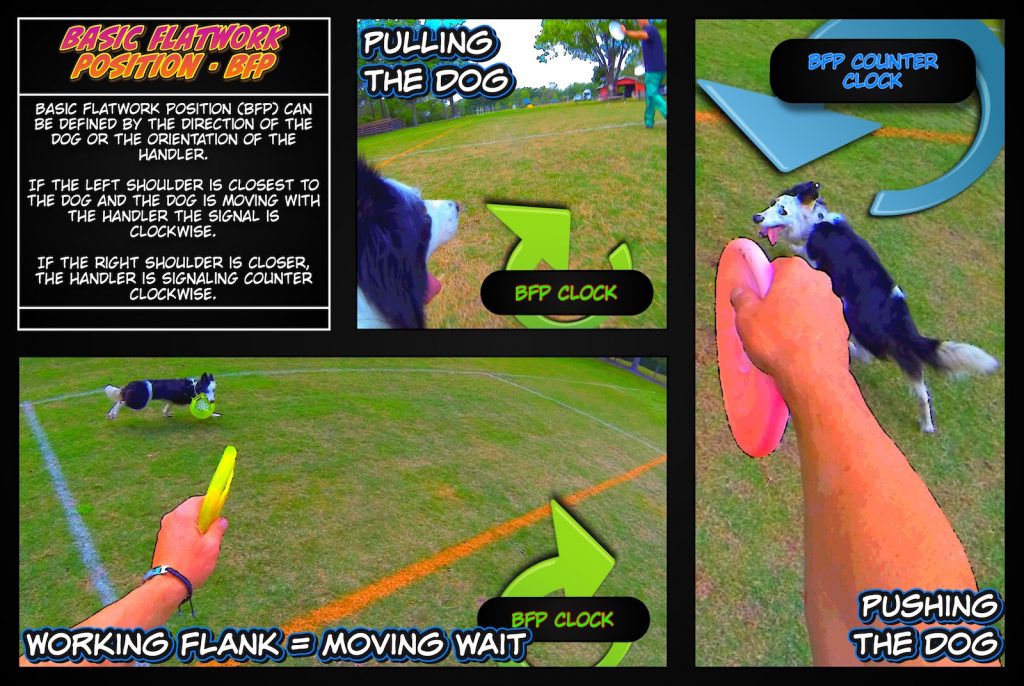
A Sample Lesson | Basic Disc Dog Positions: BSP and BFP
A sample lesson from Disc Dog Jamming Class.
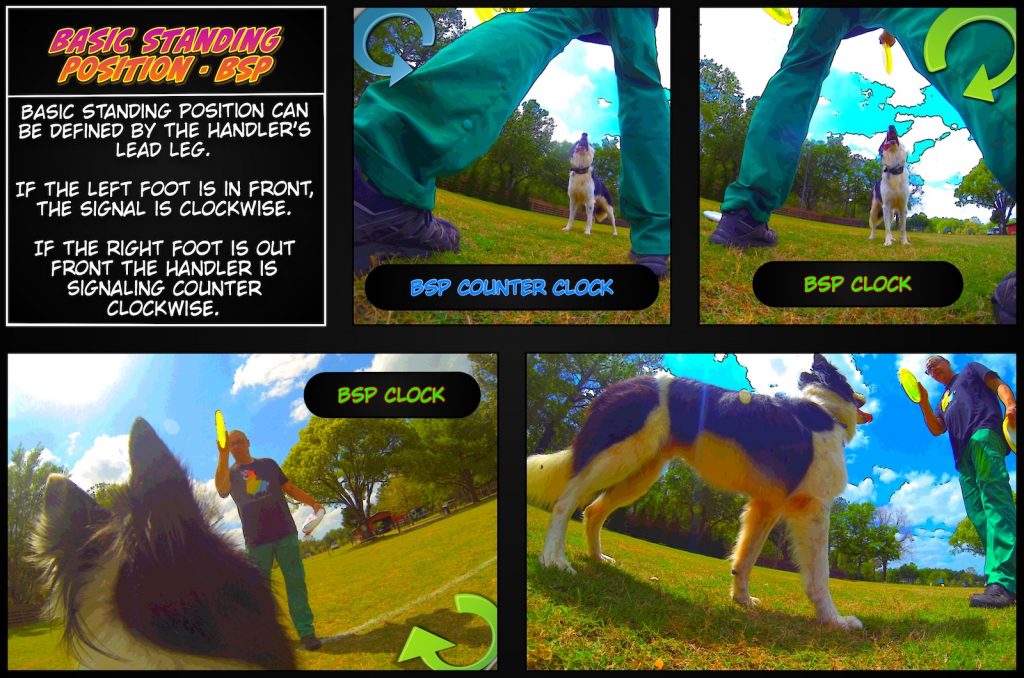
Basic Standing Position – BSP
Basic Standing PositionStanding in front of the dog with the disc held vertically in the throwing hand is Basic Standing Position (BSP), a foundational position in the Yachi Method. More BSP is the standard disc dog position. Dog standing in Front Front is a stable position directly in front of the handler. Front is an traditional obedience skill. Usually your dog sits in this position, but standing is often acceptable as well, especially in... More position attending to a vertical disc presented by the handler. This position means Stop and Wait
Front is a stable position directly in front of the handler. Front is an traditional obedience skill. Usually your dog sits in this position, but standing is often acceptable as well, especially in... More position attending to a vertical disc presented by the handler. This position means Stop and Wait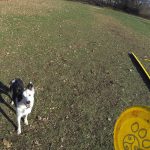 Waiting on cue and situationally is extremely important for disc dog freestyle training. The competition field might not see too much waiting going on as everything is supposed to be happening in flow,... More. It may also be a Drop cue in various training methodologies. We retain a verbal cue for the Drop to keep continuity between Basic Standing PositionIn the Play+ philosophy, "Position" is the final stage within the "Next" phase of a Cycle of Play. It acts as a pivotal link between the "Next" phase and a new "Now" phase. More and Basic Flatwork Position
Waiting on cue and situationally is extremely important for disc dog freestyle training. The competition field might not see too much waiting going on as everything is supposed to be happening in flow,... More. It may also be a Drop cue in various training methodologies. We retain a verbal cue for the Drop to keep continuity between Basic Standing PositionIn the Play+ philosophy, "Position" is the final stage within the "Next" phase of a Cycle of Play. It acts as a pivotal link between the "Next" phase and a new "Now" phase. More and Basic Flatwork Position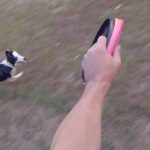 Basic Flatwork Position (BFP) is a standard position of the handler in the Working Flank; hand reaching out towards the dog (usually with a disc) with the dog on the same plane as... More BFP.
Basic Flatwork Position (BFP) is a standard position of the handler in the Working Flank; hand reaching out towards the dog (usually with a disc) with the dog on the same plane as... More BFP.
Switching from BSP clock to BSP counter is as simple as switching which foot is forward. Putting the right foot in front creates a counter clockwise tug on the dog, while putting the left foot forward pulls the dog into the handler in a clockwise direction.

Basic Flatwork Position – BFP
If a dog is moving from left to right in front of the handler they are on a clockwise flank. If they are moving right to left, they are going counter clock. If the handler has a toy, there is always a flank. Start to look for angles and positional pressure between dog and handler that influence or define a flank. This is covered very clearly in the 13 Laws of Flatwork.
Notice that the hand and disc placement looks quite similar to BSP. It’s just extended out towards the dog from the handler’s side instead of pointing towards the dog from the front of the chest.
The dog can be pulled with the flanking hand or can be pushed. If your hand is out in front of the dog, you are probably pulling. Pulling the dog too hard or too fast will tug them right in to your heel. If your hand is behind the dog slightly while on the Working Flank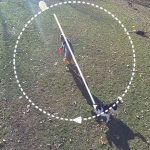 The Working Flank is a moving position. On a Working Flank the dog is out to your side some distance and holds position, moving with you as you move around the field. The... More, then you are pushing that dog around. Pushing the dog will allow the dog to stay out at a distance where reinforcement normally happens.
The Working Flank is a moving position. On a Working Flank the dog is out to your side some distance and holds position, moving with you as you move around the field. The... More, then you are pushing that dog around. Pushing the dog will allow the dog to stay out at a distance where reinforcement normally happens.
BFP can be nice and proper or a little bit sloppy. The next images are good illustrations of this. In the first image below, the handler is fairly proper. Nice straight arm, the handler utilizing the pressure of the plane of his body to control and push the dog along.
BFP is a Moving Wait
This position can be thought of as a moving wait to maintain continuity with Basic Standing Position. It can also be thought of as a moving position. The green arrows indicate a clockwise flank, and the blue signify counter clockwise movement. Notice that Loot’s eyes are glued to the handler. This is an attentive position. After all, the dog must be looking at the handler to take the pose…
A 15 month old Looter getting an introduction to flatwork from a few years ago:
Pre-Posing for Us…
This video like most of our work is “pre-posing” and pre-13 Laws of Flatwork. So the finish doesn’t look quite right, blind throws all over the place… but it is a great illustration of a young dog being introduced to disc dog flatwork.
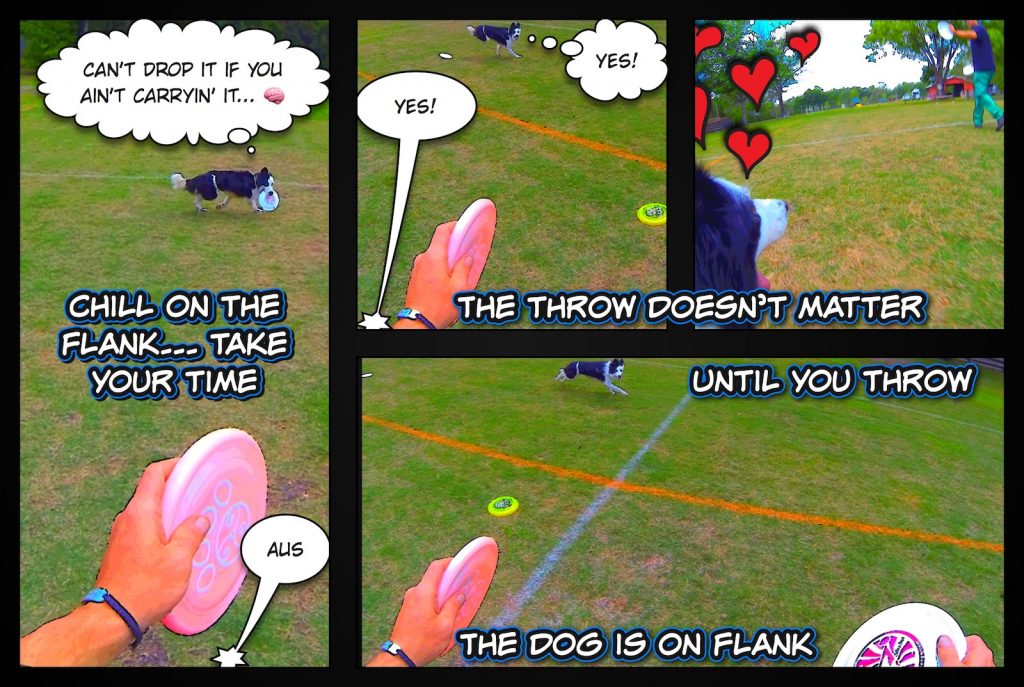
Patience on the Working Flank
Rushing on the Working Flank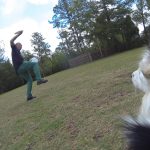 Out to the side of the handler is the Flank. If the dog is out to the handler's right or left the dog is on Flank. If the dog is moving with the... More is not necessary. It’s no more necessary than rushing into your treat bag to get a cookie. It sounds silly to think about saying,”Yes!” and then freaking out in a mad rush to dive into your treat bag. While it sounds silly in “dog training”, it is a common flaw in disc dog freestyle and dog sports.
Out to the side of the handler is the Flank. If the dog is out to the handler's right or left the dog is on Flank. If the dog is moving with the... More is not necessary. It’s no more necessary than rushing into your treat bag to get a cookie. It sounds silly to think about saying,”Yes!” and then freaking out in a mad rush to dive into your treat bag. While it sounds silly in “dog training”, it is a common flaw in disc dog freestyle and dog sports.
The throw is meaningless until you throw it.
Take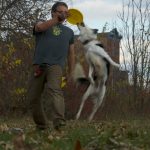 A Take is a cued Bite that replicates the placement and timing of a throw. Usually used with overs, vaults, and flips, the Take is a powerful teaching tool for creating habitual leaping... More your time. That is what your marker is for. Watch for your behavior, pounce on it with your positive marker,”Yes!“and then plan a good cookie delivery with a solid CookieA Cookie is traditionally thought of as a food treat given as positive reinforcement. In that definition, a cookie is a discrete piece of food reinforcement. In many dog training discussions, the idea... More Process.
A Take is a cued Bite that replicates the placement and timing of a throw. Usually used with overs, vaults, and flips, the Take is a powerful teaching tool for creating habitual leaping... More your time. That is what your marker is for. Watch for your behavior, pounce on it with your positive marker,”Yes!“and then plan a good cookie delivery with a solid CookieA Cookie is traditionally thought of as a food treat given as positive reinforcement. In that definition, a cookie is a discrete piece of food reinforcement. In many dog training discussions, the idea... More Process.
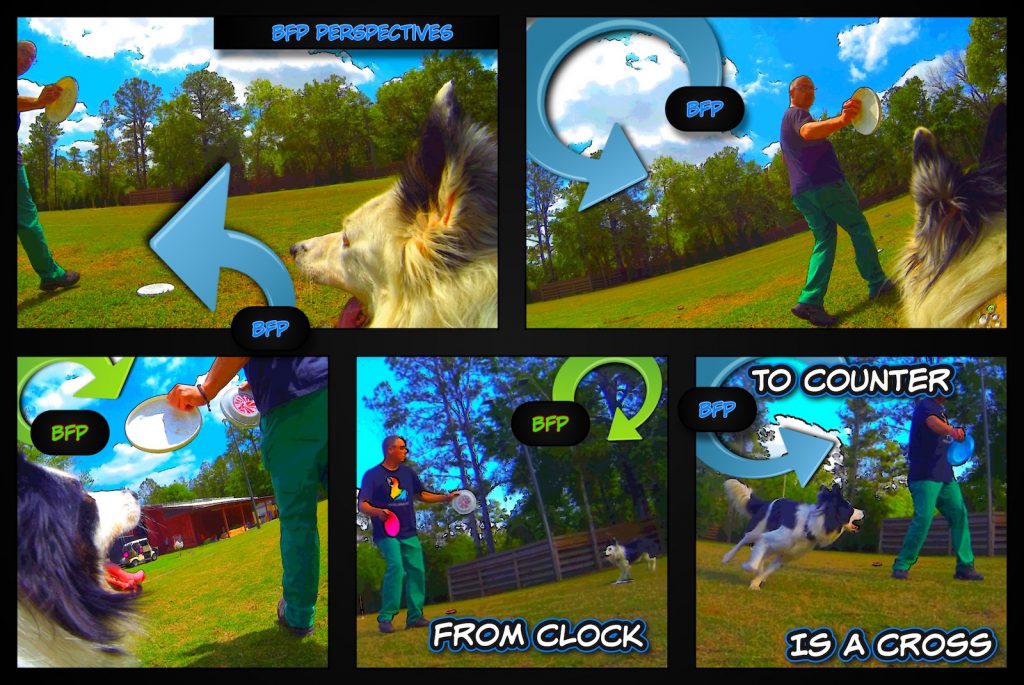
BFP Perspectives
Here are a few looks at Basic Flatwork Flatwork is the stuff that happens between the catches. How the team moves and transitions, often without the disc, is flatwork. Flatwork concepts in disc dog are taken from the agility and herding... More Position in action with Loot. Again, notice that the dog is pegged on the handler. Any time the BFP cue pops up, the dog knows that a disc is going to be happening somewhere on that line.
Flatwork is the stuff that happens between the catches. How the team moves and transitions, often without the disc, is flatwork. Flatwork concepts in disc dog are taken from the agility and herding... More Position in action with Loot. Again, notice that the dog is pegged on the handler. Any time the BFP cue pops up, the dog knows that a disc is going to be happening somewhere on that line.
Of course, Loot is a border collie, and border collies run circles naturally. But this works with all dogs to develop team movement, slow down beastly, aggressive dogs, and to provide a framework and team support to dogs that have engagement issues.
BFP and the movements depicted in the images in this lesson are traditionally thought of as Flatwork skills, or skills that are used in the “Big Game” and on longer throws. While it is true that is where it has the most impact and weight, these skills are extremely important in creating interior sequences and linking sequences together.





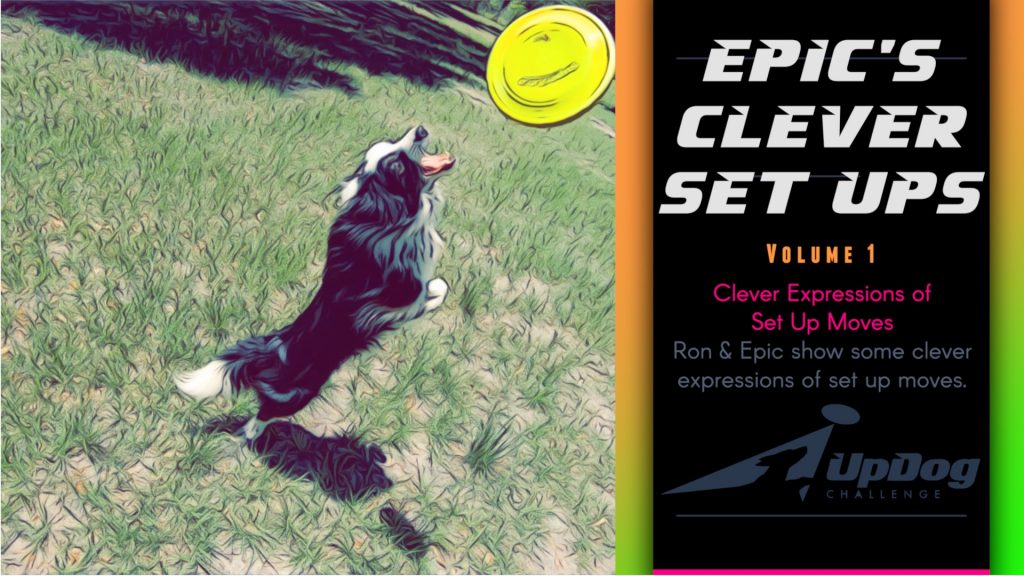

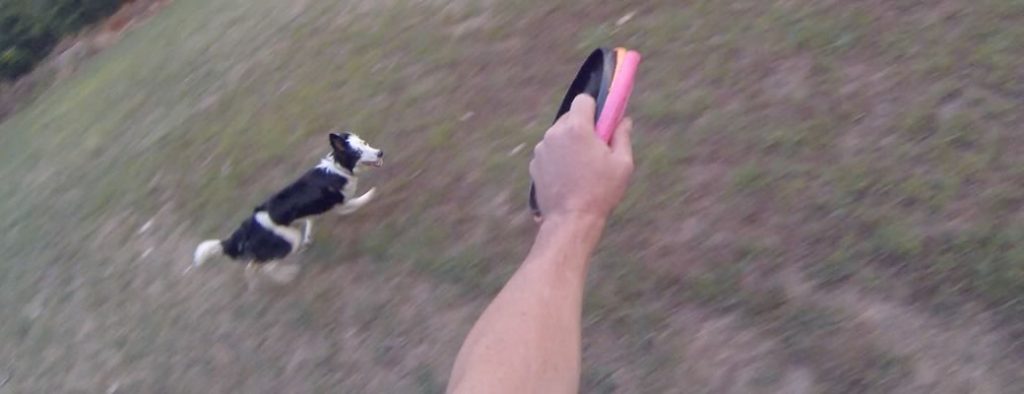
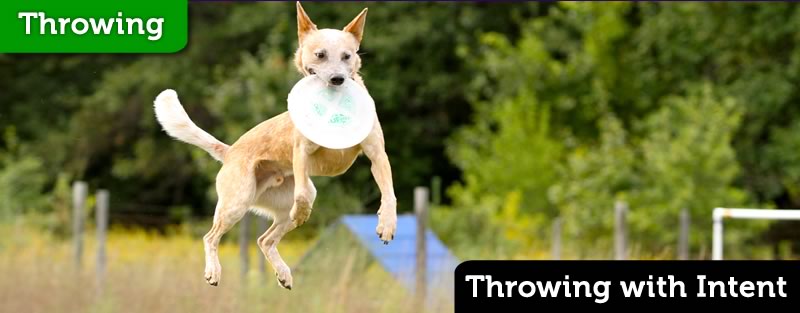
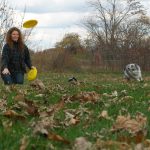
Responses